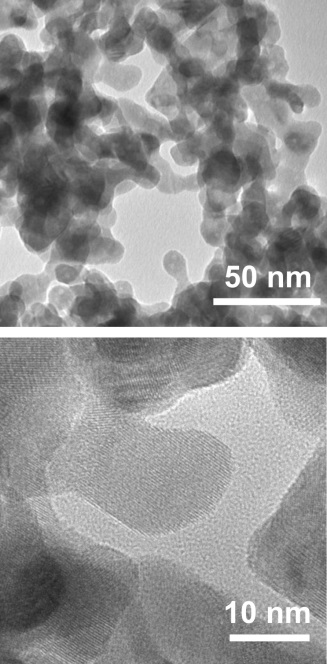
home | staff | research | teaching | lectures/seminars | how to find us | intranet
Deutsch | English

home | staff | research | teaching | lectures/seminars | how to find us | intranet
Deutsch | English
 Transmission electron micrographs of samarium oxide aerogel.
Transmission electron micrographs of samarium oxide aerogel.
Rare earth oxides (REOs) have attracted considerable attention due to their favorable properties for several catalytic applications, including complete and partial oxidation reactions and oxidative coupling of methane (OCM). REOs exhibit variable valence states and stoichiometries combined with high oxygen mobility within the oxide lattice. These properties enable the REOs to actively participate in surface redox reactions through the so-called Mars van Krevelen mechanism whereby lattice oxygen is exchanged with adsorbed reactants. For example, praseodymia and terbia have the highest oxygen mobility within the REO series and can exist in multiple phases, ranging from the sesquioxide (Ln2O3) to the dioxide (LnO2) and numerous mixed intermediate oxide phases such as Pr6O11 and Tb4O7. The ability to rapidly switch among these oxide phases facilitates oxygen exchange with adsorbates and leads to a tendency for ceria, praseodymia and terbia to promote the complete oxidation of adsorbed reactants. In contrast, REOs with lower oxygen mobility exist mainly in the sesquioxide form, and tend to be more selective toward the partial oxidation of adsorbates. Other factors influencing the catalytic behaviour are the acid-base properties. Samaria as a basic oxide, e.g., is a good OCM catalyst.
In our group we study the catalytic properties and the surface chemistry of REOs under reaction conditions as well as by means of UHV model experiments. Here, the oxidative coupling of methane is in the center of focus which is studied in close collaboration with partners at the University of Florida at Gainesville (Prof. Jason Weaver and Prof. Helena Hagelin-Weaver). Since mass transport is a decisive factor for the overall performance of a catalytic system, we are also interested in the diffusive transport of gas molecules in porous rare earth oxides (collaboration with Prof. Sergey Vasenkov, University of Florida at Gainesville). Specifically, we investigate REO aero- and xerogels, the preparation of which is well-established in the group thanks to collaboration with Dr. Alex Gash and Dr. Marcus Worsely from the Lawrence Livermore National Laboratory.
Selection of Publications:
1 J.-H. Jhang, A. Schaefer, W. Cartas, S. Epuri, M. Bäumer, J.F. Weaver, Growth and Partial Reduction of Sm2O3(111) Thin Films on Pt(111): Evidence for the Formation of SmO (100), Journal of Physical Chemistry C 117 (2013) 21396. DOI: 10.1021/jp4074416
2 B. Neumann, Th. M. Gesing, A. Rednyk, V. Matolin, A. E. Gash, M. Bäumer, Sol-gel preparation of alumina stabilized rare earth areo- and xerogels and their use as oxidation catalysts, Journal of Colloid and Interface Science 422 (2014) 71. DOI: 10.1016/j.jcis.2014.02.004
3 B. Neumann, T. W. Elkins, W. Dreher, H. Hagelin-Weaver, J. C. Nino, M. Bäumer, Enhanced catalytic methane coupling using novel ceramic foams with bimodal porosity, Catalysis Science and Technolology 3 (2013) 89. DOI: 10.1039/c2cy20458d
4 R. Mueller, S. Zhang, B. Neumann, M. Bäumer, S. Vasenkov, Study of Carbon Dioxide Transport in a Samaria Aerogel Catalyst by High Field Diffusion NMR, Chemie Ingenieur Technik 85 (2013) 1749–1754. DOI: 10.1002/cite.201300041
5 R. Mueller, S. Zhang, B. Neumann, M. Bäumer, S. Vasenkov, Self-Diffusion of Carbon Dioxide in Samaria/Alumina Aerogel Catalyst using High Field NMR Diffusometry, Journal of Chemical Physics 139 (2013) 154703. DOI: 10.1063/1.4824635